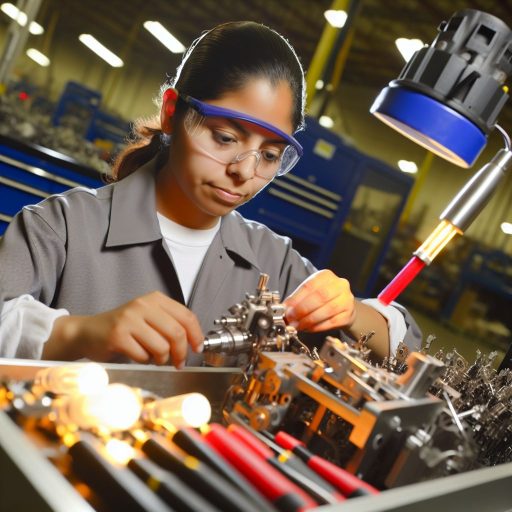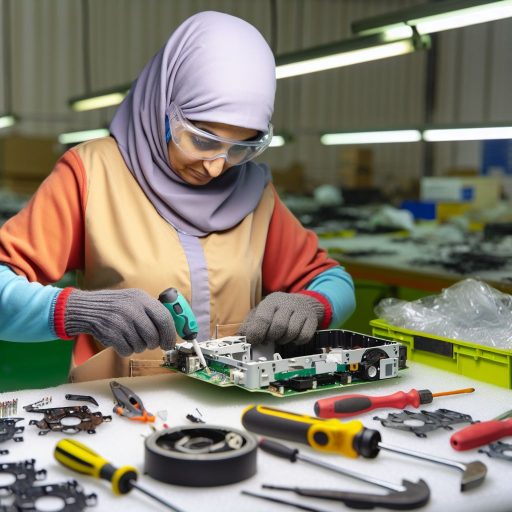Introduction:
Sheet metal fabrication involves shaping metal sheets through cutting, bending, and assembling to create various products.
This manufacturing process has a significant environmental impact due to resource consumption and waste generation.
Resource Consumption:
Sheet metal fabrication requires large quantities of raw materials like steel and aluminum, contributing to resource depletion.
Energy Usage:
The process of cutting, bending, and welding metal sheets consumes substantial amounts of energy.
Most of this energy comes from non-renewable sources.
Water Contamination:
During the cleaning and treatment of metal sheets, chemicals and contaminants can leach into water sources.
This leads to pollution of the environment.
Air Pollution:
Activities such as welding and painting release fumes and particulates into the air.
These emissions lead to air pollution and respiratory issues.
Waste Generation:
Sheet metal fabrication produces a significant amount of waste.
This includes scraps, sludge, and hazardous materials that require proper disposal.
Environmental Regulations:
Strict environmental regulations are in place to control the impact of sheet metal fabrication on the environment.
These regulations ensure sustainable practices are followed.
Overview of Sheet Metal Fabrication Process
Definition of Sheet Metal Fabrication
Sheet metal fabrication is the process of forming metal sheets into different shapes and structures through various manufacturing techniques.
Steps Involved in the Process
- Design Phase: Engineers create designs using CAD software for precise measurements.
- Material Selection: Choosing the right type of sheet metal based on the project requirements.
- Cutting: Metal sheets are cut into specific shapes using shearing or laser cutting methods.
- Forming: Metal sheets are bent, rolled, or pressed into the desired shape.
- Assembly: Different components are welded, bolted, or riveted together to create the final product.
- Finishing: Surface treatments such as painting, powder coating, or plating are applied for protection and aesthetics.
Importance of Sheet Metal in Various Industries
- Automotive Industry: Used in vehicle bodies, frames, and engine components.
- Aerospace Industry: Essential for aircraft structures due to its lightweight and durable properties.
- Construction Industry: Utilized in roofing, HVAC systems, and structural components.
- Electronics Industry: Provides housing for electronic devices and equipment.
Sheet metal fabrication plays a crucial role in manufacturing processes across multiple industries.
This enables the creation of intricate and custom-made metal products for various applications.
Energy consumption in sheet metal fabrication:
Sheet metal fabrication is a process that requires significant energy inputs to shape and cut metal sheets into various products.
This energy-intensive nature of the process has a direct impact on the environment, contributing to greenhouse gas emissions and resource depletion.
Impact of electricity and fuel consumption:
- Electricity consumption: Sheet metal fabrication shops rely heavily on electric-powered machinery such as laser cutters, punch presses, and welding equipment.
- Fuel consumption: In addition to electricity, fabrication shops also utilize fuel-powered equipment like forklifts and delivery trucks.
Ways to reduce energy consumption in fabrication shops:
- Invest in energy-efficient machinery: Upgrading to newer, more energy-efficient equipment can help reduce electricity consumption in sheet metal fabrication.
- Implement energy management systems: Installing energy monitoring systems can help track and optimize energy usage in the fabrication shop.
- Maximize natural lighting and ventilation: Utilizing natural light and airflow can reduce the need for artificial lighting and cooling systems.
- Optimize production processes: Streamlining production methods and reducing material wastage can result in lower energy consumption.
- Implement recycling programs: Recycling scrap metal and other waste materials generated in the fabrication process can help reduce energy consumption.
By implementing these energy-saving strategies, sheet metal fabrication shops can reduce their environmental footprint and contribute to a more sustainable industry.
It is essential for businesses in this sector to prioritize energy efficiency and adopt practices that minimize energy consumption while maintaining high-quality production standards.
Transform Your Career Today
Unlock a personalized career strategy that drives real results. Get tailored advice and a roadmap designed just for you.
Start NowGain More Insights: The Role of Boilermakers in Sustainable Energy
Waste generation in sheet metal fabrication:
Metal fabrication processes can generate various types of waste, including metal shavings, dust and fumes, as well as scrap metal and wastewater.
These byproducts are typically produced during cutting, bending, welding, and finishing operations.
Types of waste generated during the process:
Environmental consequences of improper waste disposal:
Improper disposal of waste generated during sheet metal fabrication can have significant environmental consequences.
Metal shavings and dust can contaminate soil and water sources, leading to pollution and potential health risks for nearby communities.
In addition, the release of harmful fumes and chemicals into the air can contribute to air pollution and climate change.
Strategies for managing and reducing waste in fabrication facilities:
To minimize the environmental impact of sheet metal fabrication, manufacturers can implement several strategies for managing and reducing waste:
- Recycling: Implementing a recycling program for scrap metal and other materials can help reduce waste sent to landfills.
- Many metals used in fabrication, such as steel and aluminum, are highly recyclable.
- Source Reduction: Reducing waste at the source by optimizing processes, improving efficiency, and implementing lean manufacturing principles can help minimize the generation of waste in fabrication facilities.
- Waste Segregation: Properly segregating and separating different types of waste materials can facilitate recycling.
- It ensures that hazardous materials are disposed of safely and responsibly.
- Use of Sustainable Materials: Choosing environmentally friendly materials and alternatives to traditional metal fabrication processes can help reduce the overall environmental impact of fabrication operations.
- Pollution Prevention: Implementing pollution prevention measures, such as capturing and treating wastewater and controlling emissions from welding and finishing processes, can help minimize environmental contamination.
By adopting these strategies and practices, sheet metal fabrication facilities can reduce their environmental impact, minimize waste generation, and contribute to a more sustainable manufacturing industry.
You Might Also Like: Building Codes and Regulations Every Mason Should Know
Major Environmental Impacts of Sheet Metal Fabrication
One of the major environmental impacts of sheet metal fabrication is air pollution.
This occurs due to the emission of various pollutants during the fabrication process.
Sources of Air Pollution in Fabrication Shops:
- Metal Cutting: The process of cutting metal sheets releases particles and fumes into the air.
- Welding: Welding metal pieces together generates fumes and gases that are harmful if inhaled.
- Painting and Coating: Applying paint or coating releases volatile organic compounds (VOCs) into the atmosphere.
Harmful Effects of Air Pollutants:
- Health Risks: Inhaling metal particles and fumes can lead to respiratory issues and other health problems.
- Environmental Damage: Pollutants like VOCs can contribute to smog formation and harm ecosystems.
- Global Impact: Air pollutants from fabrication processes can contribute to global climate change.
Technologies and Practices to Control Air Emissions:
- Use of Local Exhaust Ventilation Systems: These systems capture and remove pollutants at the source.
- Investing in Air Filtration Systems: Filtration systems can help remove harmful particles from the air.
- Switching to Low VOC Paints: Using paints with lower VOC content can reduce emissions.
- Implementing Proper Maintenance: Regular maintenance of equipment can prevent leaks and emissions.
By implementing these technologies and practices, sheet metal fabrication shops can reduce their impact on air quality.
They can protect human health and the environment.
You Might Also Like: Strategies for Effective Project Management
Water usage and contamination in sheet metal fabrication:
Water is a critical resource in sheet metal fabrication, with significant usage throughout various processes.
Many metal fabrication activities require water for cooling, lubrication, cleaning, and even as a component in some chemical processes.
Unfortunately, this high consumption of water can lead to significant water wastage and potential contamination issues.
Wastewater generated from metal fabrication processes often contains various contaminants, including metals, oils, grease, and chemicals.
These contaminants can pose serious environmental risks if not properly managed and treated before disposal.
Therefore, it is crucial for metal fabrication facilities to implement effective wastewater treatment practices to minimize environmental impact.
Transform Your Career Today
Unlock a personalized career strategy that drives real results. Get tailored advice and a roadmap designed just for you.
Start NowWater consumption in metal fabrication:
Metal fabrication processes that utilize water include cutting, grinding, welding, and surface treatment operations.
Water is used in these processes for cooling hot surfaces, reducing friction, and removing metal particles and debris.
Additionally, water is often mixed with cutting fluids and chemicals to enhance performance and improve overall process efficiency.
This heavy reliance on water makes metal fabrication facilities significant consumers of this precious resource.
Contaminants in wastewater from fabrication activities:
Wastewater generated from metal fabrication contains a variety of pollutants that can harm the environment if discharged untreated.
Common contaminants in wastewater include heavy metals like lead, chromium, and cadmium, which are toxic to aquatic life.
Other pollutants such as oils, grease, solvents, and chemicals can also be present in metal fabrication wastewater, posing additional environmental risks.
These contaminants can seep into soil and groundwater or be discharged into surface water bodies, exacerbating pollution issues.
Treatment and recycling options for contaminated water in fabrication facilities:
To mitigate the environmental impact of metal fabrication activities, wastewater treatment is essential.
Various treatment methods can be employed to remove contaminants from wastewater, including physical, chemical, and biological processes.
Physical treatment methods such as filtration and sedimentation can help to separate solid particles from water.
Chemical treatments like precipitation and coagulation can be used to remove dissolved metals and other pollutants from wastewater.
Biological treatment processes involve the use of microorganisms to break down organic matter and pollutants, promoting water quality improvement.
Once treated, the water can be recycled within the facility for non-potable purposes like cooling or cleaning, reducing the demand for fresh water.
Overall, implementing effective wastewater treatment and recycling practices is essential for minimizing the environmental impact of sheet metal fabrication.
You Might Also Like: Boilermaker Project Management Tips and Techniques

Impact on Natural Resources
Sheet metal fabrication has a significant impact on natural resources due to the depletion of raw materials from metal extraction.
The extraction process involves the removal of minerals from the earth’s crust, which can disrupt ecosystems and lead to habitat destruction.
Additionally, the environmental consequences of resource extraction for sheet metal production are substantial.
The mining and refining of metals require large amounts of energy, water, and chemicals, contributing to air and water pollution.
Transform Your Career Today
Unlock a personalized career strategy that drives real results. Get tailored advice and a roadmap designed just for you.
Start NowThese activities can also result in the generation of toxic waste that poses risks to human health and the environment.
It is crucial to prioritize sustainable sourcing practices and recycling in the sheet metal fabrication industry to minimize its environmental impact.
Sustainable sourcing involves responsibly obtaining materials from ethical suppliers who prioritize environmental conservation and social responsibility.
Furthermore, recycling plays a vital role in reducing the demand for new raw materials and minimizing waste.
By implementing recycling programs within sheet metal fabrication facilities, companies can decrease their reliance on virgin resources and promote a circular economy.
The impact of sheet metal fabrication on natural resources highlights the importance of adopting sustainable practices and prioritizing environmental responsibility in the industry.
By focusing on sustainable sourcing and recycling, companies can mitigate their environmental footprint and contribute to a more sustainable future.
- Depletion of raw materials from metal extraction
- Environmental consequences of resource extraction for sheet metal production
- Importance of sustainable sourcing and recycling in reducing environmental impact
Government regulations on environmental standards for metal fabrication
Government bodies impose strict regulations on emissions, waste disposal, and energy consumption in metal fabrication.
These regulations aim to minimize air and water pollution, as well as reduce the overall carbon footprint of the industry.
Compliance with these standards is mandatory for all sheet metal fabrication companies to operate legally.
Regular audits and inspections are conducted to ensure that manufacturers are abiding by the set environmental guidelines.
Failure to comply can result in fines, penalties, or even shutdowns of non-compliant facilities.
Industry-led initiatives to promote sustainability in sheet metal manufacturing
Many sheet metal fabrication companies are voluntarily adopting sustainable practices to minimize their environmental impact.
These initiatives include investing in energy-efficient equipment, optimizing production processes, and reducing waste generation.
Some companies are also exploring alternative materials and technologies to further enhance sustainability in their operations.
Collaborations with environmental organizations and participation in eco-friendly campaigns are common among industry players.
Continuous improvement programs are implemented to track and enhance environmental performance over time.
Compliance with environmental laws and best practices in fabrication facilities
Sheet metal fabrication facilities must adhere to a set of best practices to ensure environmental sustainability.
This includes proper handling and disposal of hazardous materials, as well as recycling and reuse of resources wherever possible.
Internal training programs are often conducted to educate employees on environmental regulations and practices.
Transform Your Career Today
Unlock a personalized career strategy that drives real results. Get tailored advice and a roadmap designed just for you.
Start NowRegular monitoring of emissions, waste output, and energy consumption is essential to identify areas for improvement.
Facilities are encouraged to seek certifications such as ISO 14001 to demonstrate their commitment to environmental responsibility.
Regulatory measures and industry initiatives play a vital role in mitigating the environmental impact of sheet metal fabrication.
By adhering to environmental standards, adopting sustainable practices, and promoting compliance with laws and best practices, the industry can contribute to a greener and more sustainable future.
Environmental Impact of Sheet Metal Fabrication
Sheet metal fabrication has a significant impact on the environment due to energy consumption and waste generation.
Stakeholders must commit to sustainable practices such as recycling and reducing emissions to mitigate environmental harm.
Compliance with regulations and use of eco-friendly materials is crucial for minimizing the negative effects.
Addressing environmental concerns in the metal fabrication sector is essential for the well-being of our planet and future generations.
It is imperative that companies and individuals in the industry take responsibility and make a concerted effort towards sustainability.
Additional Resources
Salvagnini’s Innovations in the Sheet Metal Fabrication Industry
Should I listen to my parents to not work in this metal company due …




